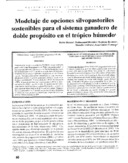| dc.contributor.author | Ibrahim, Muhammad Akbar | es_ES |
| dc.contributor.author | Botero, Javier | es_ES |
| dc.contributor.author | Louman, Bastiaan | es_ES |
| dc.contributor.author | Andrade, Hernán | es_ES |
| dc.contributor.author | Camargo García, Juan C. | es_ES |
| dc.date.accessioned | 2015-03-19T21:54:09Z | |
| dc.date.available | 2015-03-19T21:54:09Z | |
| dc.date.issued | 1999 | |
| dc.identifier | 458420 | es_ES |
| dc.identifier.issn | 1022-7482 | es_ES |
| dc.identifier.uri | https://repositorio.catie.ac.cr/handle/11554/6580 | |
| dc.description | Ilus. 3 tab. 8 ref. Sum. (En, Es). Basado en la tesis Mag. Sc. del primer autor | es_ES |
| dc.description.abstract | Programación lineal y el programa PASTOR fueron utilizados para modelar una finca ganadera de 70 ha que podría incluir: 1) pasturas naturales con y sin cercas vivas 2) mezclas de Brachiaria brizantha/Arachis pintoi 3) pasturas en callejones (B. brizantha/Erythrina berteroana) y 4) pastoreo en plantaciones de Tectona grandis. En todos estos sistemas modelados se consideró la posibilidad de plantar T. grandis en linderos, excepto en suelos infértiles y mal drenados. Si el precio de la leche se incrementa 10 o 25%, el modelo predice que la producción de leche se incrementaría 14 ó 41%, respectivamente. El modelo predice máximos ingresos netos cuando se plantan linderos de T. grandis en pasturas naturales o mezclas de B. brizantha/A. pintoi. El pastoreo de plantaciones de T. grandis no parece ser una alternativa atractiva en fincas ganaderas, a menos que los precios de la madera se incrementen en un 10%
Linear programming and the “PASTOR” programme were used to model a cattle farm of 70 ha which coil include: 1) natural pasture with and without living fence posts; 2) a Brachiaria brizanthal Arachis pintoi mixture; 3) an alley pasture (B brizanthal Erythrina berteroanna); and 4) gazing in Tectona grandis plantations. In all land use options modelled, planting T grandis in borderlines was considered, except with fertile poorly drained soils. If current milk prices were increased by 10 or 25% the model predicts that milk production will increase by 14 or 41%, respectively. Growing T grandis in borderlines of natural and B brizanthal A pintoi pastures were the land use systems selected by the model to maximise net returns. Grazing of T grandis plantations does not appear to be attractive for cattle farms unless timber prices increase by 10%. | es_ES |
| dc.language.iso | es | es_ES |
| dc.publisher | CATIE, Turrialba (Costa Rica) | es_ES |
| dc.relation.ispartof | Agroforestería en las Américas (CATIE) Volumen 6, número 23 (1999), páginas 60-62 | |
| dc.rights | info:eu-repo/semantics/openAccess | es_ES |
| dc.subject | PRODUCCION ANIMAL | es_ES |
| dc.subject | EXPLOTACIONES AGRARIAS | es_ES |
| dc.subject | GANADO | es_ES |
| dc.subject | RAZAS MIXTAS | es_ES |
| dc.subject | SISTEMAS SILVOPASCICOLAS | es_ES |
| dc.subject | ANALISIS ECONOMICO | es_ES |
| dc.subject | PROGRAMACION LINEAL | es_ES |
| dc.subject | UTILIZACION DE LA TIERRA | es_ES |
| dc.subject | BRACHIARIA BRIZANTHA | es_ES |
| dc.subject | ARACHIS PINTOI | es_ES |
| dc.subject | TECTONA GRANDIS | es_ES |
| dc.subject | TROPICOS HUMEDOS | es_ES |
| dc.subject | COSTA RICA | es_ES |
| dc.title | Modelaje de opciones silvopastoriles sostenibles para el sistema ganadero de doble propósito en el trópico húmedo | es_ES |
| dc.title.alternative | Modelling of sustainable silvopastoral options for dual purpose cattle systems in the humid tropics | es_ES |
| dc.type | Artículo | es_ES |
| dc.journal.issueNumber | 23 | |


